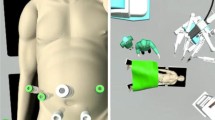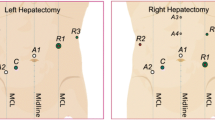Abstract
Background
Combined liver and bile duct resection with biliary reconstruction for hepatobiliary malignancies are defined as highly complex surgical procedures. The robotic platform may overcome some major limitations of conventional laparoscopic surgery for these complex cases but its precise role is however still to be defined.
Methods
In our institution, patients requiring major hepatectomy with biliary reconstruction for malignancies were consecutively selected for minimally invasive robotic surgery from September 2020. All surgeries were undertaken using the da Vinci Xi Surgical System® (Intuitive Surgical, Sunnyvale, CA, USA). Intra-operative technique and postoperative outcome were analyzed.
Results
A total number of 10 patients (3 males and 7 females, median age 72 years) underwent robotic major hepatectomy and bile duct resection for hepatobiliary malignancies between September 2020 and March 2022. The indication for surgery was perihilar cholangiocarcinoma in 5 of 10 patients. Median operative time was 338 min and median blood loss was 110 mL. Postoperative length of stay was between 3 and 16 days (median: 9 days). There was no postoperative 90-day mortality.
Conclusions
A robotic approach for hepatobiliary malignancies requiring combined major hepatectomy and bile duct resection seems feasible and safe in experienced hands.




Similar content being viewed by others
References
Ciria R, Cherqui D, Geller DA, Briceno J, Wakabayashi G (2016) Comparative short-term benefits of laparoscopic liver resection: 9000 cases and climbing. Ann Surg 263: 761-777
D’Hondt M, Tamby E, Boscart I et al (2018) Laparoscopic versus open parenchymal preserving liver resections in the posterosuperior segments: a case-matched study. Surg Endosc 32:1478–1485
Fretland AA, Dagenborg VJ, Bjørnelv GMW et al (2018) Laparoscopic versus open resection for colorectal liver metastases: the OSLO-COMET randomized controlled trial. Ann Surg 267:199–207
Schmelzle M, Krenzien F, Schöning W, Pratschke J (2020) Laparoscopic liver resection: indications, limitations, and economic aspects. Langenbecks Arch Surg 405:725–735
Ratti F, Fiorentini G, Cipriani F, Catena M, Paganelli M, Aldrighetti L (2020) Perihilar cholangiocarcinoma: are we ready to step towards minimally invasiveness? Updat Surg 72:423–433
Franken LC, van der Poel MJ, Latenstein AEJ et al (2019) Minimally invasive surgery for perihilar cholangiocarcinoma: a systematic review. J Robot Surg 13:717–727
Feng F, Cao X, Liu X et al (2019) Laparoscopic resection for Bismuth type III and IV hilar cholangiocarcinoma: how to improve the radicality without direct palpation. J Surg Oncol 120:1379–1385
Li J, Zhao L, Zhang J et al (2017) Application of the laparoscopic technique in perihilar cholangiocarcinoma surgery. Int J Surg 44:104–109
Nagino M, Ebata T, Yokoyama Y et al (2013) Evolution of surgical treatment for perihilar cholangiocarcinoma: a single-center 34-year review of 574 consecutive resections. Ann Surg 258:129–140
Lof S, Vissers FL, Klompmaker S et al (2021) Risk of conversion to open surgery during robotic and laparoscopic pancreatoduodenectomy and effect on outcomes: international propensity score-matched comparison study. Br J Surg 108:80–87
Lof S, van der Heijde N, Abuawwad M et al (2021) Robotic versus laparoscopic distal pancreatectomy: multicentre analysis. Br J Surg 108:188–195
Ciria R, Berardi G, Alconchel F et al (2020) The impact of robotics in liver surgery: a worldwide systematic review and short-term outcomes meta-analysis on 2728 cases. J Hepatobiliary Pancreat Sci. https://doi.org/10.1002/jhbp.869
D’Hondt M, Wicherts DA (2022) Robotic biliary surgery for benign and malignant bile duct obstruction: a case series. J Robot Surg. https://doi.org/10.1007/s11701-022-01392-y
Clavien PA, Barkun J, de Oliveira ML et al (2009) The Clavien-Dindo classification of surgical complications: five-year experience. Ann Surg 250:187–196
Zhang Y, Dou C, Wu W et al (2019) Total laparoscopic versus open radical resection for hilar cholangiocarcinoma. Surg Endosc. https://doi.org/10.1007/s00464-019-07211-0
Levi Sandri GB, Spoletini G, Mascianà G et al (2017) The role of minimally invasive surgery in the treatment of cholangiocarcinoma. Eur J Surg Oncol 43:1617–1621
Hawksworth J, Radkani P, Nguyen B et al (2021) Robotic hepaticojejunostomy for late anastomotic biliary stricture after liver transplantation: technical description and case series. Ann Surg. https://doi.org/10.1097/SLA.0000000000005303
Sucandy I, Shapera E, Jacob K et al (2021) Robotic resection of extrahepatic cholangiocarcinoma: institutional outcomes of bile duct cancer surgery using a minimally invasive technique. J Surg Oncol 125:161–167
Wang W, Fei Y, Liu J, Yu T, Tang J, Wei F (2021) Laparoscopic surgery and robotic surgery for hilar cholangiocarcinoma: an updated systematic review. ANZ J Surg 91:42–48
Li J, Tan X, Zhang X et al (2020) Robotic radical surgery for hilar cholangiocarcinoma: a single-centre case series. Int J Med Robot 16:e2076
Xu Y, Wang H, Ji W et al (2016) Robotic radical resection for hilar cholangiocarcinoma: perioperative and long-term outcomes of an initial series. Surg Endosc 30:3060–3070
Kone LB, Bystrom PV, Maker AV (2022) Robotic surgery for biliary tract cancer. Cancers 14:1046
Guerrini GP, Esposito G, Magistri P et al (2020) Robotic versus laparoscopic gastrectomy for gastric cancer: the largest meta-analysis. Int J Surg 82:210–228
Bagante F, Tran T, Spolverato G et al (2016) Perihilar cholangiocarcinoma: number of nodes examined and optimal lymph node prognostic scheme. J Am Coll Surg 222:750–759
Funding
None.
Author information
Authors and Affiliations
Corresponding author
Ethics declarations
Disclosures
Dr. Mathieu D’Hondt and Dr. Dennis Wicherts have no conflicts of interest or financial ties to disclose.
Additional information
Publisher's Note
Springer Nature remains neutral with regard to jurisdictional claims in published maps and institutional affiliations.
Rights and permissions
Springer Nature or its licensor (e.g. a society or other partner) holds exclusive rights to this article under a publishing agreement with the author(s) or other rightsholder(s); author self-archiving of the accepted manuscript version of this article is solely governed by the terms of such publishing agreement and applicable law.
About this article
Cite this article
D’Hondt, M., Wicherts, D.A. Pure robotic major hepatectomy with biliary reconstruction for hepatobiliary malignancies: first European results. Surg Endosc 37, 4396–4402 (2023). https://doi.org/10.1007/s00464-023-09863-5
Received:
Accepted:
Published:
Issue Date:
DOI: https://doi.org/10.1007/s00464-023-09863-5




